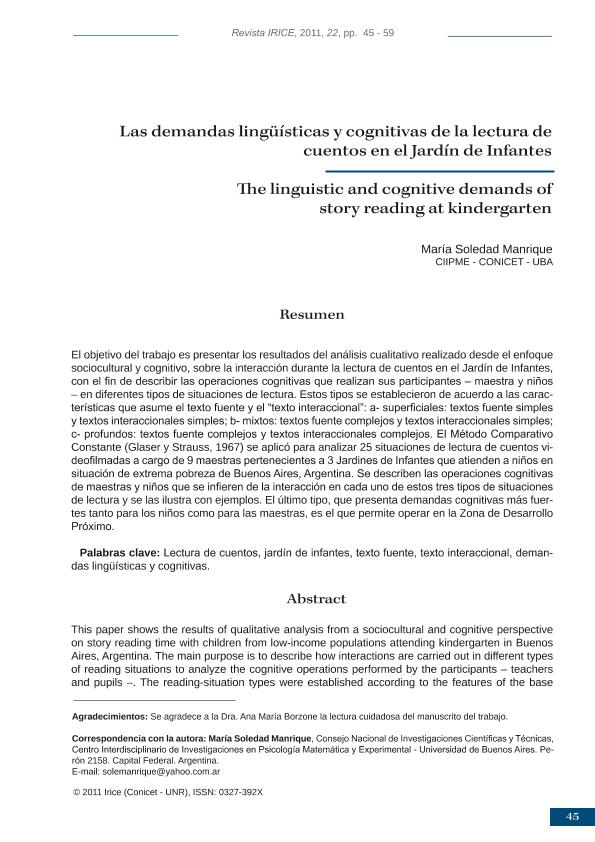Artículo
El objetivo del trabajo es presentar los resultados del análisis cualitativo realizado desde el enfoque sociocultural y cognitivo, sobre la interacción durante la lectura de cuentos en el Jardín de Infantes, con el fin de describir las operaciones cognitivas que realizan sus participantes " maestra y niños " en diferentes tipos de situaciones de lectura. Estos tipos se establecieron de acuerdo a las características que asume el texto fuente y el texto interactivo a- superficiales: textos fuente simples y textos interactivos simples; b- mixtos: textos fuente complejos y textos interactivos simples; c- profundos: textos fuente complejos y textos interactivos complejos. El Método Comparativo Constante (Glaser y Strauss, 1967) se aplicó para analizar 25 situaciones de lectura de cuentos videofilmadas a cargo de nueve maestras pertenecientes a tres Jardines de Infantes que atienden a niños en situación de extrema pobreza de Buenos Aires, Argentina. Se describen las operaciones cognitivas de maestras y niños que se infieren de la interacción en cada uno de estos tres tipos de situaciones de lectura y se las ilustra con ejemplos. El último tipo, que presenta demandas cognitivas más fuertes tanto para los niños como para las maestras, es el que permite operar en la zona de desarrollo próximo. This paper shows the results of qualitative analysis from a sociocultural and cognitive perspective on story reading time with children from low-income populations attending kindergarten in Buenos Aires, Argentina. The main purpose is to describe how interactions are carried out in different types of reading situations to analyze the cognitive operations performed by the participants – teachers and pupils –. The reading-situation types were established according to the features of the base text and the “interactional text”: a- shallow: simple texts and superficial interactional texts; b- mixed: complex texts and superficial interactional texts; c- deep: complex texts and deep interactional texts. The Comparative Constant Method (Glaser and Strauss, 1967) was employed to analyze 25 story- reading situations by 9 teachers. These situations were videotaped at 3 kindergarten classes. Tea- chers and children’s cognitive operations were inferred from the interaction in each type of situation (i.e., shallow, mixed and deep) and illustrated with examples. Our findings show that the last type, which implies the strongest cognitive demands both for pupils and teachers, allows operating in the Zone of Poximal Development.
Las demandas lingüísticas y cognitivas de la lectura de cuentos en el Jardín de Infantes.
Título:
The linguistic and cognitive demands of story reading at kindergarten
Fecha de publicación:
04/2011
Editorial:
CONICET
Revista:
IRICE
e-ISSN:
0327-392X
Idioma:
Español
Tipo de recurso:
Artículo publicado
Clasificación temática:
Resumen
Archivos asociados
Licencia
Identificadores
Colecciones
Articulos(CIIPME)
Articulos de CENTRO INTER. DE INV. EN PSICOLOGIA MATEMATICA Y EXP. "DR. HORACIO J.A RIMOLDI"
Articulos de CENTRO INTER. DE INV. EN PSICOLOGIA MATEMATICA Y EXP. "DR. HORACIO J.A RIMOLDI"
Citación
Manrique, Maria Soledad; Las demandas lingüísticas y cognitivas de la lectura de cuentos en el Jardín de Infantes.; CONICET; IRICE; 22; 4-2011; 45-59
Compartir




